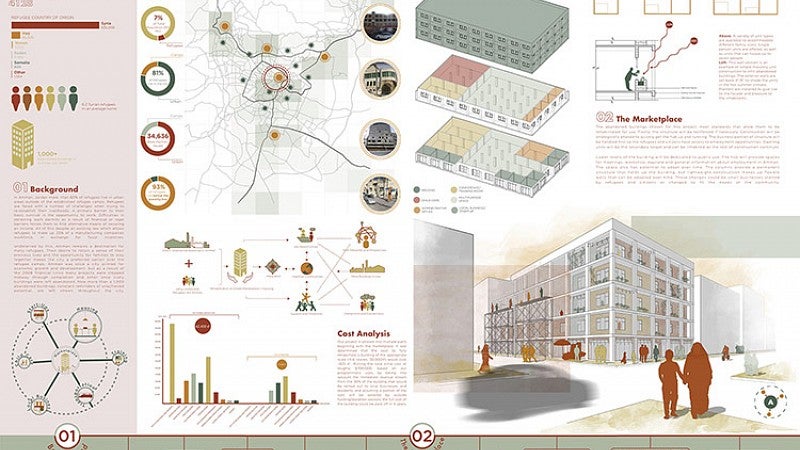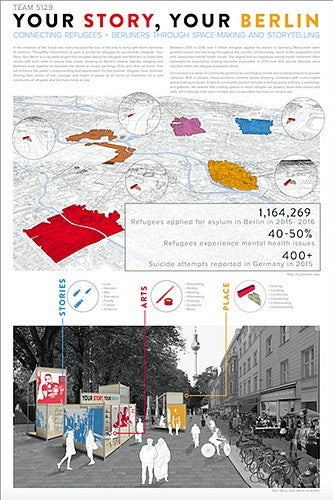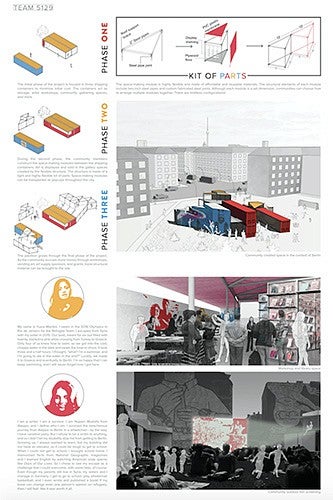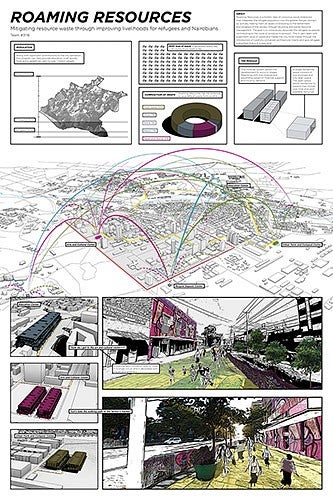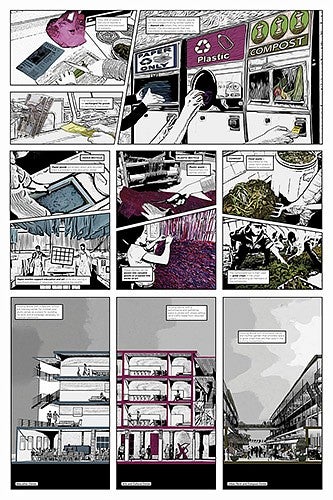Above: Images from "New Life in Forgotten Spaces " project.
When University of Oregon Architecture Professor Howard Davis saw an announcement for a competition aimed at designing safe spaces for refugees, he realized immediately that it would be an appropriate starting point for his terminal studio called “Living in a New Land,” which began in winter term and concludes this spring.
“The competition seemed like the perfect way to begin a studio on refugees and refugee housing. It allowed the students to work together in ways that introduced them to the varied issues concerning the lives and problems of people who have been displaced,” said Davis.
Three groups of five students each from “Living in a New Land” entered the Place and Displacement: Integrating Refugee Populations within Cities competition sponsored by International Development in Action (IDeA). They took home 3 of the 17 prizes awarded—one first prize and two honorable mentions. The first prize includes a cash award of $2,000.
For the competition, students were asked to provide solutions to address the economic and social vulnerabilities that refugees face in urban environments and provide creative ways to expand access, participation, and interaction between refugees and their local communities. Students could choose to design for one of three cities: Amman, Jordan; Berlin, Germany; or Nairobi, Kenya. The winning entry was for Amman, and the honorable mentions were for Berlin and Nairobi.
“The students’ solutions were varied, reflecting the conditions of three very different cities, and provided a great introduction to their individual projects that followed the competition. The fact that we had three winners was, of course, a tremendous bonus,” said Davis.
By the Numbers
17 finalists were selected from:
200+ proposals
400+ participants
100 Universities
40 countries
The winning projects were:
- New Life in Forgotten Spaces (Amman): Harley Elliott, Kristin Erhardt, Weiran Liu, Chris Luna, Joshua Skinner
- Your Story, Your Berlin: Alexandra “Ali” Lau, Noah Roesler, Carl Berry, Craig Speck, and Dan Qin
- Roaming Resources (Nairobi): Tim Walsh, Scarlet Weaver, Ana Misenas, Nathaniel Leigh, Achyuthan Ramaswamy
When asked about working on the projects, several students had insights to share. Scarlet Weaver, who is pursuing a bachelor’s degree in architecture, said, “It was very interesting to watch the three groups solve problems differently. The refugee problem is not the same problem everywhere. It was also interesting to see how different cities might respond differently. Some cities are more welcoming and others less so.”
Ali Lau, a dual master’s student getting ready to graduate this year with degrees in architecture and community and regional planning noted that in “studio we often work alone, and while we have a lot of creative control, working in a team allowed us to branch off into different perspectives that all came together into something beautiful.”
Currently working toward a bachelor’s degree in architecture, Dan Qin observed that “working both in studio and competition brought our different thoughts together, and sharing helped us think about refugees in three different cultures. It was a wonderful experience to design this and to think about how to contribute to a community.”
Students in the School of Architecture & Environment are committed to architecture that makes the human condition better, whether focused on sustainability or social justice. “I hope this studio has helped students understand the predicament of people whose lives are affected by a rapidly changing world and the importance of putting themselves into other people’s shoes as they prepare to enter the professional world,” said Davis.
Above: Images from "Your Story, Your Berlin" and "Roaming Resources" projects.

